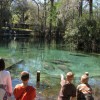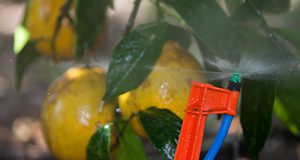Wastewater carries pathogens, nutrients (nitrogen and phosphorus), and trace organic chemicals that may be harmful to human health and ecosystem functioning. Thus, proper treatment of wastewater is crucial. While septic systems can be one means of effective wastewater treatment, there are some special considerations for their use in Florida because of unique geography and sandy soils. The purpose of this new 6-page publication of the UF/IFAS Department of Soil and Water Sciences is to explain the basics of how septic systems work and how they can affect springs water quality in Florida, with a special emphasis on potential N loading from septic systems. This document is intended for homeowners, the general public, and county, city, and other local personnel tasked with managing water quality in areas with septic systems. Written by Mary Lusk, Andrea Albertin, Whitney Elmore, William Lester, and James Moll.
https://edis.ifas.ufl.edu/ss693
Tag: Rivers and Springs
Handbook of Florida Water Regulation: Florida Springs and Aquifer Protection Act
This handbook is designed to provide an accurate, current, and authoritative summary of the principal federal and state laws that directly or indirectly relate to agriculture. Written by Tatiana Borisova, Michael T. Olexa, and Jarrett Davis and published by the UF/IFAS Food and Resource Economics Department, this chapter of the handbook provides a basic overview of the Florida Springs and Aquifer Protection Act.
http://edis.ifas.ufl.edu/fe1019
Economic Contributions and Ecosystem Services of Springs in the Lower Suwannee and Santa Fe River Basins of North-Central Florida
 This study examined the economic contributions, consumer surplus, and ecosystem services provided by recreational use of fifteen major springs sites in north central Florida. The estimated annual economic contributions of springs-related recreational spending in north-central Florida for FY 2012/13 are summarized. Among the findings, there was $84.2 million in total visitor spending for springs recreation, and 1,160 full- and part-time jobs. This 4-page fact sheet was written by Tatiana Borisova, Alan W. Hodges, and Thomas J. Stevens, and published by the UF Department of Food and Resource Economics, April 2015.
This study examined the economic contributions, consumer surplus, and ecosystem services provided by recreational use of fifteen major springs sites in north central Florida. The estimated annual economic contributions of springs-related recreational spending in north-central Florida for FY 2012/13 are summarized. Among the findings, there was $84.2 million in total visitor spending for springs recreation, and 1,160 full- and part-time jobs. This 4-page fact sheet was written by Tatiana Borisova, Alan W. Hodges, and Thomas J. Stevens, and published by the UF Department of Food and Resource Economics, April 2015.
http://edis.ifas.ufl.edu/fe958
Economic Value of the Services Provided by Florida Springs and Other Water Bodies: A Summary of Existing Studies
 Florida residents and visitors place a high value on aquatic natural resources. This 8-page fact sheet reviews nine studies that demonstrate that Florida’s springs have a very large economic value, both for recreation and resource conservation. In these studies, economists measure the value of ecosystem services in dollar terms to assist management decisions concerning natural resources. Willingness to pay studies show that people who benefit from Florida springs place a high value on them. Economic contribution studies show that Florida springs play a significant role in local and state economic health and job creation. Written by Sara Wynn, Tatiana Borisova, and Alan Hodges, and published by the UF Department of Food and Resource Economics, November 2014. (UF/IFAS Photo by Tyler Jones.)
Florida residents and visitors place a high value on aquatic natural resources. This 8-page fact sheet reviews nine studies that demonstrate that Florida’s springs have a very large economic value, both for recreation and resource conservation. In these studies, economists measure the value of ecosystem services in dollar terms to assist management decisions concerning natural resources. Willingness to pay studies show that people who benefit from Florida springs place a high value on them. Economic contribution studies show that Florida springs play a significant role in local and state economic health and job creation. Written by Sara Wynn, Tatiana Borisova, and Alan Hodges, and published by the UF Department of Food and Resource Economics, November 2014. (UF/IFAS Photo by Tyler Jones.)
http://edis.ifas.ufl.edu/fe959

